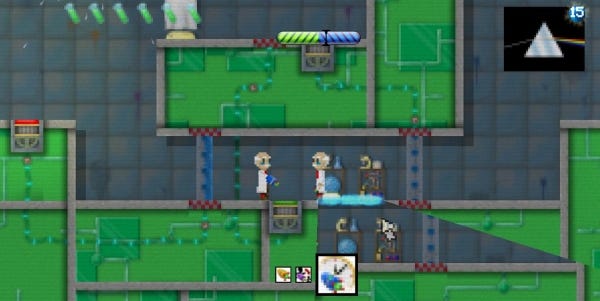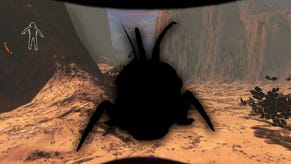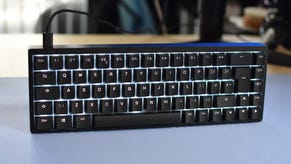Portalmanteau: Why You Should Play The Gateways Beta
A-door-able
I can't remember the last time I played a game challenging enough that it had me stop, sit back in my chair, and just think for a bit. That's the rare pleasure the beta version of Gateways offers, as the fantastic puzzles start piling up. How can I, using my various tools such as changing size, portaling, and going back in time, reflect that laser onto that laser receiver, without my brain exploding? We can all find out answers to such questions now, as the beta version of the game is for sale for $10 from Smudged Cat Games. My thoughts on it are below.
I don't know if you've seen the mind-hurting indie time travel film Primer. I'm still at a loss as to whether I'd recommend it - it's the only film I've seen where reading about it after felt like spoilers. But at the centre of its paradox-inducing mechanics is the Feynman-esque concept of having to live the day you're going to time travel during first, then going back to before it started and living simultaneously with yourself, until you reach the point where your originals entered the time machine and essentially their existence ends. Look - there's a useful diagram here.
That's how the time travel in Gateways works. And you'll have to spend that couple of minutes getting your head around it before you can use it usefully. You create an exit portal from where you will re-emerge in the past, wait until a time meter is full (the equivalent of Primer's characters having to lie for hours in their machine), then fire an entrance portal. You've got the second half of the time meter to do your actions, then hop into the portal, re-emerge before you started and then co-exist (without touching, of course) for the first half of the time meter. You know, that. And yet it remains an extremely playable and cute platformer.
Time travel doesn't come straight away. The first gun you receive is a more familiar portal device. Entrance, exit, jump through. In a 2D pixelly platformer, that manages to be just as reality-confusing as ever, and is portrayed so perfectly here. Issues with the earlier demo are fixed, meaning placing portals is no longer a fiddly pain, and instead you're quickly leaping through sideways-facing holes to reach distant platforms like the pro you are.
If Gateways stopped there it would be a platformer to rival Portal: The Flash Version. But it doesn't, by a long stretch. Shortly after you'll receive the size-changing gun. It works on the same portal principles, except this time you'll change scale as you go through, either growing smaller or larger, as the puzzles demand. But bear in mind this isn't just clicking a button to change size - it's going through a portal to do it: you have to combine the two dimensional shifts together to do it usefully.
Before time travel comes along you're also equipped with a torch, and a mirror, and with these many more puzzle variations appear, which are then all thrown into a swirling pot of cerebral ow once you mix in being able to briefly exist alongside yourself.
Which brings us back to my being sat back in my chair, arms on my head, thinking. Because the game just added a second loop of time travel, and now I'm co-existing with myself three times over, and my head hurts and I'm not halfway through the game. Right, think this through with me.
I'm here. There are three doors, and three buttons that open them. a with a, b with b, c with c. The half blue doors allow portals to be fired through the blue side, but not the grey side. The third door cannot be fired through. I'm trying to get through to the other side of door c. So if I stand on a, create a time portal exit on the wall to the right, then an entrance to my left, I can easily hop through, go through the open door a, and stand on button b. That opens the top door. The me on button a will now disappear so door a is closed. But I can fire another time portal on the wall to the left, through door a, and then drop through there, jump up and go through door b that the other me is keeping open, and be on button c. But a fat lot of good that does me, because having door c open is no use if door a isn't open too. I need to be on buttons c and a at the same time, and also run through the corridor. But because you can't fire two sets of any types of portal together, it's not as simple as creating a standard portal while my duplicate is on button a, because it won't fire while the time portal is open, and as soon as it's closed, the me on button c won't exist any more and door c will have closed.
I can create a time portal while stood on button c, the exit above button a, and the entrance on the wall to the right, and then be stood on both buttons. But in order to loop a second time, I'd need to go back through the portal next to button c, and there's no way back there without being stood on button b, which would mean not being stood on button a...
The game does provide help if you need it, but here I'd say is the only really significant flaw I've encountered. There are Help Points, which for 15 blue blobs will tell you if you have what you need to solve a particular puzzle, and then for another 35 will show you an in-game video (really neatly too - the video begins wherever your character is currently stood, which is a lovely touch) of how to complete the challenge. However, the numbers of blue blobs are limited, such that you can't just cheat your whole way through the game. But the issue is the 15 blobs to tell you if you can do a puzzle. They end up eating your supply, such that if you do get stuck, you're unlikely to have enough. I'm not sure why just knowing if you're equipped to solve a puzzle should be quite so expensive, since divining if you've the right weaponry isn't really something the player should have to do. I'd much prefer to see this stage at, say, 5 blobs, which would seem a lot more fair.
It looks absolutely lovely. The pixel main character in a slightly more refined world, creates a fantastic look, accompanied by a collection of superb sound effects. And for a beta, with just a few sticky issues with task switching (although I believe this bug has been fixed now), it's in an extremely solid state. I really can't recommend this highly enough - a genuinely smart, incredibly challenging puzzle platformer, that's just packed with ideas and extremely well executed. And from having played the first half, I can't see an issue with jumping in now at the beta. (There's also a free demo, but I'm unaware if it's improved over the dodgy version Craig and Adam played.)
The final version is out on the 22nd June, but like I say, if you don't mind the last few bugs I'd suggest grabbing this one as soon as possible.














